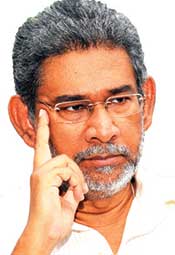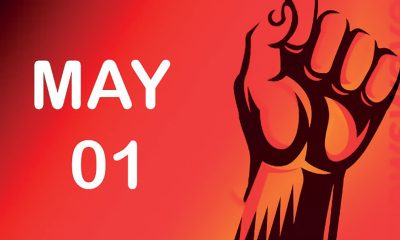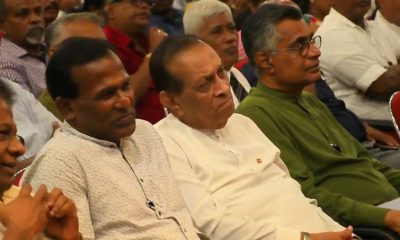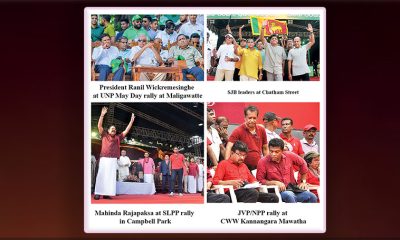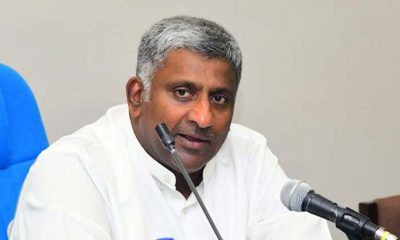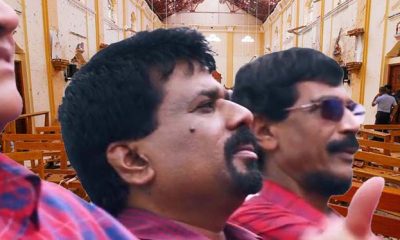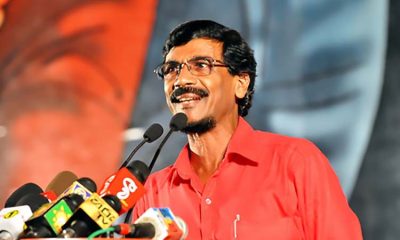Features
The Wijeweera Legacy and Left Prospects Today
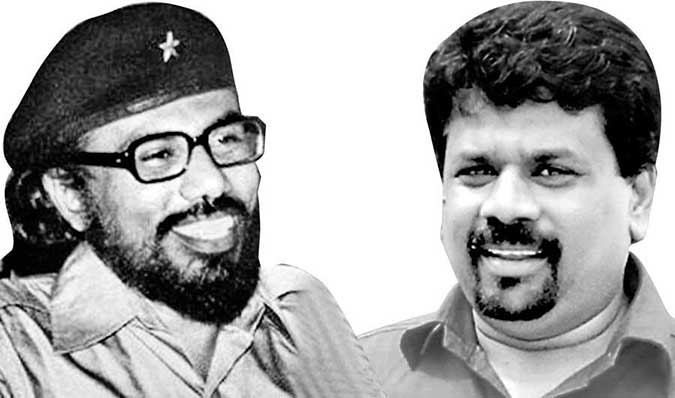
by Dr. Dayan Jayatilleka
The Left in Sri Lanka is closer than it has ever been to leading the country. This is borne out by public opinion polling which consistently puts Anura Kumara Dissanayake (AKD) the JVP-NPP leader ahead of the competition at a presidential election and his party or bloc, the NPP-JVP ahead of the competition at a parliamentary election.
The mystery is that AKD and the JVP-NPP aren’t doing everything it can, or even the minimum things it can, to increase its slim lead and get to the magic 50% mark. In every other situation everywhere in the world in which the Left has come within striking distance of electoral victory, or indeed victory of any sort, the natural reflex has been to seek to close the gap through tweaking its own policies and profile so as to elasticize its appeal while reaching out and building political partnerships, alliances, blocs, in a word, political relationships, that bring it home to victory.
This has been the lesson of Pink Tide one and two which has seen the democratic Left sweep Latin America twice in the past quarter century. It has also been the experience of the Marxist-Leninist left in Nepal.
That is precisely what the JVP-NPP is not doing. I was discussing this paradox with an incisive young friend who earned a postgraduate degree in international relations in a First World university before he became the business magnate he is. “If the JVP and the FSP united it would give rise to brilliant synergy, but the JVP believes in competitive advantage, not cooperative advantage. It would rather lose, persisting in comparative advantage than win, switching to cooperative advantage” he opined.
Political Genetics
Where did this self-limitation, this chronic inability to form inter-party/cross-party political relationships come from? Why is it persisted in even at the risk of losing the elections?
More puzzling, why is it indulged in even though it prevents the JVP-NPP’s ability to wrench an election from the reluctant Ranil Wickremesinghe?
Why is it adhered to even though it hamstrings, the JVP-NPP’s ability to protect its trade unions from the vicious labor legislation that is imminent, and/or the sell-off of the state sector of the economy which houses many of those unions?
The reason, the cause, lies in the genetic structure, the genetic code of the JVP. Those political-ideological genes are the source of the JVP’s strength and its weakness. To seek the real reason, one has to return to the JVP’s roots; its paternity.
Rohana Wijeweera was the most significant or consequential left leader this island ever produced. He grasped what Georg Lukacs, writing of Lenin, described as “the actuality of the revolution”. Though he had several contemporaries who had the same idea and strivings, without Wijeweera, revolution would never really have come on the agenda of Sri Lankan history. His real strength was a combination of two attributes. Firstly, the ability to apply and adapt—which in his case, tragically involved great distortion—Marxism-Leninism to the specifics of the Sri Lankan reality and the sociology of the underprivileged Lankan youth. Secondly, the ability to organize and instill in his followers the zeal to organize.
No Wijeweera, no JVP; no JVP, no real challenge to the Sri Lankan capitalist system and capitalist class. No Wijeweera, no real challenge to the Sri Lankan state. No JVP, no FSP offshoot, and no really effective Left on the island. No effective Left, no alternative or counterbalance to the capitalist politicians or the savage neoliberal cutbacks. No JVP and FSP and no counterforce, or even voice, for the disadvantaged masses, the youth from the poorer classes and generations educated in the state universities.
There is a flipside, or as they say, the matter needs a dialectical approach. If not for Wijeweera’s strengths, no JVP challenge to the System, but if not for Wijeweera’s weaknesses, those challenges would not have been so distorted as be successfully beaten down. Look at the track record. Two significant armed uprisings, both smashed militarily, punctuated and followed by desultory-to-modest electoral performance so far.
Compare and contrast that with Latin America where the Left either managed to use its military strength to force negotiations and the re-opening of the system which permitted electoral participation culminating in victory and re-election, or even in cases of utter military devastation, retained enough of a moral-ethical halo, to win Presidential elections.
What is the reason? While Wijeweera’s strength lent the JVP determination and resilience, his chronic weaknesses also imposed structural limits on its success. His paranoia made him see any competitor or dissenter as an enemy who had to be dealt with violently. This aborted any possibility of united fronts, alliances, and blocs, i.e., any partnership or more plainly, political relationships. It was a self-fulfilling prophecy. The enemies he and the JVP made on the Left through lethal violence, turned out to be the decisive factor in the JVP’s crushing military defeat in 1989.
This paranoia, though in a greatly reduced form, has been carried on to the next generation through the JVP’s DNA. It is mercifully, far more diluted in the breakaway FSP. However, the FSP, while much less sectarian, is not entirely immune either. In a Southern European or Latin American context, an FSP-type party would have united either with other left parties (that’s how Syriza and Podemos were formed) or worked within the SJB and/or FPC.
Tamil Question
Wijeweera had a chronic inability to formulate a Marxist solution to the Tamil National Question—that is, apart from writing a 350-page book (his report to the underground party Congress in 1985) which had more consecutive pages criticizing me by name than Velupillai Prabhakaran.
Though the JVP and FSP have abandoned his ‘social chauvinism’ – which Wimal Weerawansa is continuing – and are laudably anti-racist parties, they too have baulked at embracing the standard Marxist and Left formulation of ‘regional autonomy’. Instead, the JVP wobbles while the FSP still flirts occasionally with ‘self-determination’ – which Wijeweera was correct to reject and I was wrong not to. The result of this Wijeweera legacy has been a political paralysis of both the JVP and the FSP on the Tamil Question which prevents any kind of North-South political bridge-building or even an extended conversation.
Surplus Violence
Electorally, the biggest liability of the Wijeweera period is the character of the violence of the second uprising in the late 1980s. Both the JVP and the FSP have been unable to get beyond the old justificatory narrative of “the UNP framed us and banned us, so we had no choice but to fight back”. That narrative is often supplemented with “the Indians projected power onto our soil so we had to resist it arms in hand”.
Taken separately or together, the justificatory narrative fails to deal with the issue of barbarism as manifested in targeting. What does the UNP’s ban on the JVP or the Indian airdrop and the Accord have to do with the very first political assassination by the JVP in the 1980s, namely the slitting of the throat of Daya Pathirana, the leader of the radical left Independent Students Union, who had signed a petition in 1984 calling for the removal of the ban on the JVP, and was murdered on December 15, 1986, many months before the Indian intervention?
The problem is not with the JVP taking up arms but the use those arms were put to. Is there no way for the JVP and the breakaway FSP to reaffirm the legitimacy of its recourse to arms with a self-criticism of the lethal targeting of unarmed rivals and non-compliant civilians targeting which made bitter enemies of other radical leftists who then proved to be the critical variable in the JVP’s defeat? Why not a self-criticism of the needless and ultimately suicidal decision to continue or resume the civil war when a real chance had arisen to negotiate an honourable solution and even enter the government when the newly-elected, non-elite, populist President Premadasa invited it to do so?
The failure to make a public self-criticism about aspects of its armed struggle reduces the level of public trust that the JVP-NPP could otherwise count on because of the economic crisis. In some areas there are horrific memories of JVP violence and persecution of the people (snatching ID
cards, imposing curfews, strictures on funerals etc.). These votes could comprise the margin of victory or defeat and yet the JVP is unwilling to do its due diligence to secure them.
Erasing Theory
Finally, there is the perhaps the most important drawback of the Wijeweera legacy that the JVP and FSP share, and should cut clean away from if the Left is to win or even survive Ranil’s counter-revolutionary offensive.
After 1973 or perhaps 1976, Rohana Wijeweera sealed the JVP off from the rich, complex legacy, theoretical and strategic, of the post-Lenin international communist and revolutionary movement. It happened this way. After the defeat of the April 1971 insurrection the incarcerated JVP cadres and those underground and on the run began to read. The reading led to calls for self-criticism and efforts at self-criticism. These were met with violence directed at the dissenters by Wijeweera’s faithful in the jails.
Being the very smart guy he was, Wijeweera knew this was not enough. He then engaged in a massive diversion operation. He diverted attention to the support extended to the Bandaranaike government by the ruling Communist parties of Russia and more dramatically China and went on a huge binge against the international communist movement. His lawyer the celebrated Trotskyist Bala Tampoe was giving him considerable reading material, chiefly the writings of Ernest Mandel.
Ever the utilitarian, Wijeweera switched from his 1973 position of endorsing independent-minded Communist parties non-aligned between Russia and China, i.e., Cuba, Vietnam, North Korea, Japan, and the Communist Party of India-Marxist, to a complete rupture which took the Trotskyist position that international communism had been incorrupt only up to the first four Congresses of the Communist International (Comintern). In short, it pretty much had all gone wrong after Lenin, except for the positions of the ‘Left Opposition’ (Trotsky, Zinoviev, Radek, Preobrazhensky) against Stalin.
Wijeweera being Wijeweera, he dumped this ‘ultra-internationalism’ when the party was unfairly banned by the UNP and went underground. He then switched to its opposite position, adopting ultra nationalism in his 1985 book, denouncing any and every form of political devolution down to the District Development Councils which the JVP had itself contested.
Original Sin
What is most pertinent to the situation today, is that in order to facilitate a free hand for himself to swing from one position to its opposite, Wijeweera maintained the cut-off point at Lenin and there too, suppressing his ‘Two Tactics’ (1905). This meant that decades of Marxist and revolutionary thought after Lenin was de-legitimized, denounced, or ignored; unavailable to and discouraged among JVP leaders and members. Wijeweera reserved for himself the right to toss in the names of Fidel, Che, Miguel Enriquez (founder of the Chilean MIR) et al, without ever quoting at length from them, still less discussing, debating and assimilating their ideas. It was simply name-dropping.
Mao, Gramsci, Dimitrov, Togliatti, Ho Chi Minh, Fidel Castro, Che Guevara, Amilcar Cabral, Carlos Fonseca, Joe Slovo. None of these were read at length or discussed in depth. The entire conceptualization of United Fronts and the Popular Front, in their many variations, was effaced.
This is the real reason that the JVP does not engage in united fronts with other political parties. This is the real reason the JVP will be mentally unable to do so until it exorcises this ghost of the negative side of Wijeweera’s political paternity.
The treasure house of Marxist thought was shut to the JVP by Wijeweera and never really reopened by him or his successors. The FSP is much more open but it is like the man who escaped Plato’s cave and is blinking in the sunlight. As Plato explained, in a reference to the fate of Socrates, when such an escapee goes back to his fellow prisoners and tries to explain the outside world to them, they are likely to kill him because all they know are the shadows flickering on the walls of the cave.
Meanwhile, the badly defeated Latin American left was deeply studying Gramsci, supplemented by Althusser and Poulantzas. That was the secret of its successful comeback. Though some of those parties had been founded after the JVP and defeated militarily, they were elected to the presidency in their countries well before the JVP found its political and electoral feet.
[Dayan Jayatilleka is author of ‘The Great Gramsci: Imagining an Alt-Left Project’, in On Public Imagination: A Political and Ethical Imperative, eds. Richard Falk et al, Routledge 2019]
Features
The heart-friendly health minister

by Dr Gotabhya Ranasinghe
Senior Consultant Cardiologist
National Hospital Sri Lanka
When we sought a meeting with Hon Dr. Ramesh Pathirana, Minister of Health, he graciously cleared his busy schedule to accommodate us. Renowned for his attentive listening and deep understanding, Minister Pathirana is dedicated to advancing the health sector. His openness and transparency exemplify the qualities of an exemplary politician and minister.
Dr. Palitha Mahipala, the current Health Secretary, demonstrates both commendable enthusiasm and unwavering support. This combination of attributes makes him a highly compatible colleague for the esteemed Minister of Health.
Our discussion centered on a project that has been in the works for the past 30 years, one that no other minister had managed to advance.
Minister Pathirana, however, recognized the project’s significance and its potential to revolutionize care for heart patients.
The project involves the construction of a state-of-the-art facility at the premises of the National Hospital Colombo. The project’s location within the premises of the National Hospital underscores its importance and relevance to the healthcare infrastructure of the nation.
This facility will include a cardiology building and a tertiary care center, equipped with the latest technology to handle and treat all types of heart-related conditions and surgeries.
Securing funding was a major milestone for this initiative. Minister Pathirana successfully obtained approval for a $40 billion loan from the Asian Development Bank. With the funding in place, the foundation stone is scheduled to be laid in September this year, and construction will begin in January 2025.
This project guarantees a consistent and uninterrupted supply of stents and related medications for heart patients. As a result, patients will have timely access to essential medical supplies during their treatment and recovery. By securing these critical resources, the project aims to enhance patient outcomes, minimize treatment delays, and maintain the highest standards of cardiac care.
Upon its fruition, this monumental building will serve as a beacon of hope and healing, symbolizing the unwavering dedication to improving patient outcomes and fostering a healthier society.We anticipate a future marked by significant progress and positive outcomes in Sri Lanka’s cardiovascular treatment landscape within the foreseeable timeframe.
Features
A LOVING TRIBUTE TO JESUIT FR. ALOYSIUS PIERIS ON HIS 90th BIRTHDAY

by Fr. Emmanuel Fernando, OMI
Jesuit Fr. Aloysius Pieris (affectionately called Fr. Aloy) celebrated his 90th birthday on April 9, 2024 and I, as the editor of our Oblate Journal, THE MISSIONARY OBLATE had gone to press by that time. Immediately I decided to publish an article, appreciating the untiring selfless services he continues to offer for inter-Faith dialogue, the renewal of the Catholic Church, his concern for the poor and the suffering Sri Lankan masses and to me, the present writer.
It was in 1988, when I was appointed Director of the Oblate Scholastics at Ampitiya by the then Oblate Provincial Fr. Anselm Silva, that I came to know Fr. Aloy more closely. Knowing well his expertise in matters spiritual, theological, Indological and pastoral, and with the collaborative spirit of my companion-formators, our Oblate Scholastics were sent to Tulana, the Research and Encounter Centre, Kelaniya, of which he is the Founder-Director, for ‘exposure-programmes’ on matters spiritual, biblical, theological and pastoral. Some of these dimensions according to my view and that of my companion-formators, were not available at the National Seminary, Ampitiya.
Ever since that time, our Oblate formators/ accompaniers at the Oblate Scholasticate, Ampitiya , have continued to send our Oblate Scholastics to Tulana Centre for deepening their insights and convictions regarding matters needed to serve the people in today’s context. Fr. Aloy also had tried very enthusiastically with the Oblate team headed by Frs. Oswald Firth and Clement Waidyasekara to begin a Theologate, directed by the Religious Congregations in Sri Lanka, for the contextual formation/ accompaniment of their members. It should very well be a desired goal of the Leaders / Provincials of the Religious Congregations.
Besides being a formator/accompanier at the Oblate Scholasticate, I was entrusted also with the task of editing and publishing our Oblate journal, ‘The Missionary Oblate’. To maintain the quality of the journal I continue to depend on Fr. Aloy for his thought-provoking and stimulating articles on Biblical Spirituality, Biblical Theology and Ecclesiology. I am very grateful to him for his generous assistance. Of late, his writings on renewal of the Church, initiated by Pope St. John XX111 and continued by Pope Francis through the Synodal path, published in our Oblate journal, enable our readers to focus their attention also on the needed renewal in the Catholic Church in Sri Lanka. Fr. Aloy appreciated very much the Synodal path adopted by the Jesuit Pope Francis for the renewal of the Church, rooted very much on prayerful discernment. In my Religious and presbyteral life, Fr.Aloy continues to be my spiritual animator / guide and ongoing formator / acccompanier.
Fr. Aloysius Pieris, BA Hons (Lond), LPh (SHC, India), STL (PFT, Naples), PhD (SLU/VC), ThD (Tilburg), D.Ltt (KU), has been one of the eminent Asian theologians well recognized internationally and one who has lectured and held visiting chairs in many universities both in the West and in the East. Many members of Religious Congregations from Asian countries have benefited from his lectures and guidance in the East Asian Pastoral Institute (EAPI) in Manila, Philippines. He had been a Theologian consulted by the Federation of Asian Bishops’ Conferences for many years. During his professorship at the Gregorian University in Rome, he was called to be a member of a special group of advisers on other religions consulted by Pope Paul VI.
Fr. Aloy is the author of more than 30 books and well over 500 Research Papers. Some of his books and articles have been translated and published in several countries. Among those books, one can find the following: 1) The Genesis of an Asian Theology of Liberation (An Autobiographical Excursus on the Art of Theologising in Asia, 2) An Asian Theology of Liberation, 3) Providential Timeliness of Vatican 11 (a long-overdue halt to a scandalous millennium, 4) Give Vatican 11 a chance, 5) Leadership in the Church, 6) Relishing our faith in working for justice (Themes for study and discussion), 7) A Message meant mainly, not exclusively for Jesuits (Background information necessary for helping Francis renew the Church), 8) Lent in Lanka (Reflections and Resolutions, 9) Love meets wisdom (A Christian Experience of Buddhism, 10) Fire and Water 11) God’s Reign for God’s poor, 12) Our Unhiddden Agenda (How we Jesuits work, pray and form our men). He is also the Editor of two journals, Vagdevi, Journal of Religious Reflection and Dialogue, New Series.
Fr. Aloy has a BA in Pali and Sanskrit from the University of London and a Ph.D in Buddhist Philosophy from the University of Sri Lankan, Vidyodaya Campus. On Nov. 23, 2019, he was awarded the prestigious honorary Doctorate of Literature (D.Litt) by the Chancellor of the University of Kelaniya, the Most Venerable Welamitiyawe Dharmakirthi Sri Kusala Dhamma Thera.
Fr. Aloy continues to be a promoter of Gospel values and virtues. Justice as a constitutive dimension of love and social concern for the downtrodden masses are very much noted in his life and work. He had very much appreciated the commitment of the late Fr. Joseph (Joe) Fernando, the National Director of the Social and Economic Centre (SEDEC) for the poor.
In Sri Lanka, a few religious Congregations – the Good Shepherd Sisters, the Christian Brothers, the Marist Brothers and the Oblates – have invited him to animate their members especially during their Provincial Congresses, Chapters and International Conferences. The mainline Christian Churches also have sought his advice and followed his seminars. I, for one, regret very much, that the Sri Lankan authorities of the Catholic Church –today’s Hierarchy—- have not sought Fr.
Aloy’s expertise for the renewal of the Catholic Church in Sri Lanka and thus have not benefited from the immense store of wisdom and insight that he can offer to our local Church while the Sri Lankan bishops who governed the Catholic church in the immediate aftermath of the Second Vatican Council (Edmund Fernando OMI, Anthony de Saram, Leo Nanayakkara OSB, Frank Marcus Fernando, Paul Perera,) visited him and consulted him on many matters. Among the Tamil Bishops, Bishop Rayappu Joseph was keeping close contact with him and Bishop J. Deogupillai hosted him and his team visiting him after the horrible Black July massacre of Tamils.
Features
A fairy tale, success or debacle

Sri Lanka-Singapore Free Trade Agreement
By Gomi Senadhira
senadhiragomi@gmail.com
“You might tell fairy tales, but the progress of a country cannot be achieved through such narratives. A country cannot be developed by making false promises. The country moved backward because of the electoral promises made by political parties throughout time. We have witnessed that the ultimate result of this is the country becoming bankrupt. Unfortunately, many segments of the population have not come to realize this yet.” – President Ranil Wickremesinghe, 2024 Budget speech
Any Sri Lankan would agree with the above words of President Wickremesinghe on the false promises our politicians and officials make and the fairy tales they narrate which bankrupted this country. So, to understand this, let’s look at one such fairy tale with lots of false promises; Ranil Wickremesinghe’s greatest achievement in the area of international trade and investment promotion during the Yahapalana period, Sri Lanka-Singapore Free Trade Agreement (SLSFTA).
It is appropriate and timely to do it now as Finance Minister Wickremesinghe has just presented to parliament a bill on the National Policy on Economic Transformation which includes the establishment of an Office for International Trade and the Sri Lanka Institute of Economics and International Trade.
Was SLSFTA a “Cleverly negotiated Free Trade Agreement” as stated by the (former) Minister of Development Strategies and International Trade Malik Samarawickrama during the Parliamentary Debate on the SLSFTA in July 2018, or a colossal blunder covered up with lies, false promises, and fairy tales? After SLSFTA was signed there were a number of fairy tales published on this agreement by the Ministry of Development Strategies and International, Institute of Policy Studies, and others.
However, for this article, I would like to limit my comments to the speech by Minister Samarawickrama during the Parliamentary Debate, and the two most important areas in the agreement which were covered up with lies, fairy tales, and false promises, namely: revenue loss for Sri Lanka and Investment from Singapore. On the other important area, “Waste products dumping” I do not want to comment here as I have written extensively on the issue.
1. The revenue loss
During the Parliamentary Debate in July 2018, Minister Samarawickrama stated “…. let me reiterate that this FTA with Singapore has been very cleverly negotiated by us…. The liberalisation programme under this FTA has been carefully designed to have the least impact on domestic industry and revenue collection. We have included all revenue sensitive items in the negative list of items which will not be subject to removal of tariff. Therefore, 97.8% revenue from Customs duty is protected. Our tariff liberalisation will take place over a period of 12-15 years! In fact, the revenue earned through tariffs on goods imported from Singapore last year was Rs. 35 billion.
The revenue loss for over the next 15 years due to the FTA is only Rs. 733 million– which when annualised, on average, is just Rs. 51 million. That is just 0.14% per year! So anyone who claims the Singapore FTA causes revenue loss to the Government cannot do basic arithmetic! Mr. Speaker, in conclusion, I call on my fellow members of this House – don’t mislead the public with baseless criticism that is not grounded in facts. Don’t look at petty politics and use these issues for your own political survival.”
I was surprised to read the minister’s speech because an article published in January 2018 in “The Straits Times“, based on information released by the Singaporean Negotiators stated, “…. With the FTA, tariff savings for Singapore exports are estimated to hit $10 million annually“.
As the annual tariff savings (that is the revenue loss for Sri Lanka) calculated by the Singaporean Negotiators, Singaporean $ 10 million (Sri Lankan rupees 1,200 million in 2018) was way above the rupees’ 733 million revenue loss for 15 years estimated by the Sri Lankan negotiators, it was clear to any observer that one of the parties to the agreement had not done the basic arithmetic!
Six years later, according to a report published by “The Morning” newspaper, speaking at the Committee on Public Finance (COPF) on 7th May 2024, Mr Samarawickrama’s chief trade negotiator K.J. Weerasinghehad had admitted “…. that forecasted revenue loss for the Government of Sri Lanka through the Singapore FTA is Rs. 450 million in 2023 and Rs. 1.3 billion in 2024.”
If these numbers are correct, as tariff liberalisation under the SLSFTA has just started, we will pass Rs 2 billion very soon. Then, the question is how Sri Lanka’s trade negotiators made such a colossal blunder. Didn’t they do their basic arithmetic? If they didn’t know how to do basic arithmetic they should have at least done their basic readings. For example, the headline of the article published in The Straits Times in January 2018 was “Singapore, Sri Lanka sign FTA, annual savings of $10m expected”.
Anyway, as Sri Lanka’s chief negotiator reiterated at the COPF meeting that “…. since 99% of the tariffs in Singapore have zero rates of duty, Sri Lanka has agreed on 80% tariff liberalisation over a period of 15 years while expecting Singapore investments to address the imbalance in trade,” let’s turn towards investment.
Investment from Singapore
In July 2018, speaking during the Parliamentary Debate on the FTA this is what Minister Malik Samarawickrama stated on investment from Singapore, “Already, thanks to this FTA, in just the past two-and-a-half months since the agreement came into effect we have received a proposal from Singapore for investment amounting to $ 14.8 billion in an oil refinery for export of petroleum products. In addition, we have proposals for a steel manufacturing plant for exports ($ 1 billion investment), flour milling plant ($ 50 million), sugar refinery ($ 200 million). This adds up to more than $ 16.05 billion in the pipeline on these projects alone.
And all of these projects will create thousands of more jobs for our people. In principle approval has already been granted by the BOI and the investors are awaiting the release of land the environmental approvals to commence the project.
I request the Opposition and those with vested interests to change their narrow-minded thinking and join us to develop our country. We must always look at what is best for the whole community, not just the few who may oppose. We owe it to our people to courageously take decisions that will change their lives for the better.”
According to the media report I quoted earlier, speaking at the Committee on Public Finance (COPF) Chief Negotiator Weerasinghe has admitted that Sri Lanka was not happy with overall Singapore investments that have come in the past few years in return for the trade liberalisation under the Singapore-Sri Lanka Free Trade Agreement. He has added that between 2021 and 2023 the total investment from Singapore had been around $162 million!
What happened to those projects worth $16 billion negotiated, thanks to the SLSFTA, in just the two-and-a-half months after the agreement came into effect and approved by the BOI? I do not know about the steel manufacturing plant for exports ($ 1 billion investment), flour milling plant ($ 50 million) and sugar refinery ($ 200 million).
However, story of the multibillion-dollar investment in the Petroleum Refinery unfolded in a manner that would qualify it as the best fairy tale with false promises presented by our politicians and the officials, prior to 2019 elections.
Though many Sri Lankans got to know, through the media which repeatedly highlighted a plethora of issues surrounding the project and the questionable credentials of the Singaporean investor, the construction work on the Mirrijiwela Oil Refinery along with the cement factory began on the24th of March 2019 with a bang and Minister Ranil Wickremesinghe and his ministers along with the foreign and local dignitaries laid the foundation stones.
That was few months before the 2019 Presidential elections. Inaugurating the construction work Prime Minister Ranil Wickremesinghe said the projects will create thousands of job opportunities in the area and surrounding districts.
The oil refinery, which was to be built over 200 acres of land, with the capacity to refine 200,000 barrels of crude oil per day, was to generate US$7 billion of exports and create 1,500 direct and 3,000 indirect jobs. The construction of the refinery was to be completed in 44 months. Four years later, in August 2023 the Cabinet of Ministers approved the proposal presented by President Ranil Wickremesinghe to cancel the agreement with the investors of the refinery as the project has not been implemented! Can they explain to the country how much money was wasted to produce that fairy tale?
It is obvious that the President, ministers, and officials had made huge blunders and had deliberately misled the public and the parliament on the revenue loss and potential investment from SLSFTA with fairy tales and false promises.
As the president himself said, a country cannot be developed by making false promises or with fairy tales and these false promises and fairy tales had bankrupted the country. “Unfortunately, many segments of the population have not come to realize this yet”.
(The writer, a specialist and an activist on trade and development issues . )

